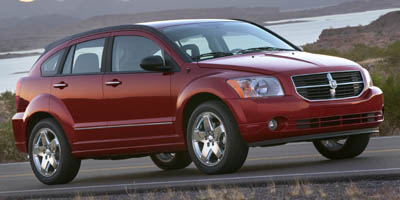Most car buyers don't think a lot about transmissions. In the U.S., more than 9 out of 10 of them opt for an automatic, and that's that.
But transmission technology turns out to be one of the major ways automakers are boosting gas mileage to meet tougher fuel-economy rules.
And it appears GM is about to make a major transition on that front.
DON'T MISS: Auto Industry Doing Fine In Meeting Gas-Mileage Goals, It Turns Out (Aug 2014)
According to industry trade journal Ward's Auto, General Motors is tooling up to use a new continuously variable transmissions (CVTs) in many of its high-volume car lines.
Taking that path puts GM in the company of Toyota and Honda. Both have fitted CVTs, rather than conventional automatic transmissions that use torque converters, in high-volume vehicles that include the latest Toyota Corolla and Honda Accord.
Nissan has long been the biggest proponent of CVTs, having used them across most of its lineup for a decade or more.

2007 Dodge Caliber
Detroit makers Ford and what is now Fiat Chrysler both fitted CVTs to certain models during the 2000s, then moved back to conventional automatics due to consumer complaints.
The principle of a CVT is to use expanding pulleys and belts to permit an infinite number of ratios matching engine speed to torque output--letting the engine run at its most efficient speed rather than stepping it through a set of fixed ratios.
The problem is that earlier CVTs often ignored consumer familiarity with how regular automatics worked, and often ran engines immediately up to their highest output when acceleration was needed.
ALSO SEE: GM's New 3- And 4-Cylinder Engines Face Off Against Ford, VW (May 2014)
That led to a major disconnect between engine noise and road speed, which many drivers found disconcerting.
Now, many companies that use CVTs--most notably Subaru--adjust the transmission's behavior to step through simulated "gears" under certain types of acceleration, providing a more predictable and familiar experience to drivers.
The rest of the time, though, the latest CVTs subtly adjust their ratios to keep engine speed at its most efficient. That goes entirely unnoticed by drivers.

GM’s next-gen Ecotec engines
According to Ward's, the new transmission is designed to pair with GM's new family of three- and four-cylinder engines, which it introduced earlier this year and plans to use in products across the globe.
While the first U.S. use of those new engines will be in the 2016 Chevrolet Volt plug-in hybrid, that car uses the Voltec electric-drive system with its own transmission.
To date, the sole CVT fitted to a GM vehicle in the U.S. is the one used in the Chevrolet Spark minicar, which replaced a widely disliked four-speed automatic used only in 2013, the year the Spark was launched in North America.
MORE: 2014 Chevrolet Spark With CVT: Gas Mileage Review (May 2014)
GM's new transmission is likely to appear around 2019 in a number of "high-volume products," Ward's suggests, citing sources within the industry.
The automaker is now bringing suppliers into the fold, issuing requests for proposals on supplying high volumes of the components needed within the transmission, it said.
The impetus behind all of this is boosting fuel efficiency, to meet the steadily rising corporate average fuel economy (CAFE) regulations in effect from now through 2025.

2014 Chevrolet Spark, Catskill Mountains, Apr 2014
GM already uses a six-speed automatic transmissions across the board in its front-wheel-drive products, from subcompacts through large utility vehicles.
Whereas Fiat Chrysler now fits nine-speed automatics to its new products, it appears GM feels CVTs will be the better option.
As for the driving characteristics, we'll have to wait a few years to see.
_______________________________________________













